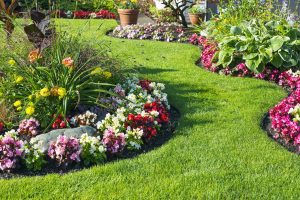Why Fall Planting?
Air temperatures are dropping, but the soil is still quite warm – perfect for root development. Fall temperatures are also more pleasant for the gardener, so grab your favorite spade or trowel and get ready to dig.
Create a Spring Garden this Fall
 Planting the seed for a beautiful spring garden begins in the fall. Some of the most beautiful plants and flowers to emerge under the warmth of the sun include lilies, hostas, peonies, irises, ferns, and ornamental grasses. If you dream of coloring your yard next spring, fall is the time to get started.
Planting the seed for a beautiful spring garden begins in the fall. Some of the most beautiful plants and flowers to emerge under the warmth of the sun include lilies, hostas, peonies, irises, ferns, and ornamental grasses. If you dream of coloring your yard next spring, fall is the time to get started.
- August through September is a great time to begin shopping and planning.
- Late September through early November is the time to plant.
- Spring is the time to watch amazing colors bloom from the ground.
Choose from a Selection of Beautiful Flowers
Lilies
Imagine how wonderful lilies will look once the chill of winter leaves and the refreshing breeze of spring rolls in. If you love lilies, the best time to plant lily bulbs is usually from mid-September through mid-October. They don’t need much care and can grow into a large arrangement of eye-catching beauty.
Hosta (or Plantain Lily)
August is a great time to plant hostas. Once they peek through the ground to greet you this spring, you may notice that some are funnel-shaped, some are bell-shaped and some offer a fragrance while others don’t. You can expect to see hostas in purple, blue, green, yellow, white and white with lavender stripes. They can bloom anytime from June to October.
Peonies
The best time to plant peonies is in early fall as this allows feeder roots several weeks of growing time before the ground freezes. Peonies are unique in that they can be grown in any garden, and they don’t need much care. Once they’re planted, they only need partial to full sun. Another great feature is that they can live in a variety of climates and soil.
Irises
When it comes to garden plants, irises are simply great. They grow in a range of climates and bloom in a variety of colors, including blue and purple, white and yellow, pink and orange, brown and red, and even black, so it’s not surprising that the name iris means rainbow. Make sure your irises receive light.
Ferns
Ferns are also gorgeous in the spring. When it comes to planting them, keep in mind that it’s important to keep them away from direct sunlight.
- Loosen the soil to a depth of 12 inches and amend the soil with organic material such as leaf mold.
- As you plant the ferns, make sure the roots are covered with about 2 inches of soil.
- Make sure there are at least 15 inches of space between the ferns (24 inches for larger varieties.)
- Cover your ferns with leaves or evergreen boughs to protect them from snow and ice. Leave them covered until the threat of frost has ended.
Ornamental Grasses
Many gardeners consider ornamental grasses a favorite. That could be because they come in all colors and sizes and don’t require much work. Another great thing about ornamental grasses is that they attract birds, which can add an accent to any garden.
Bulbs
Blooming bulbs are a symbol of spring, but fall is the time to plant them. Hardy bulbs such as tulip, crocus, daffodil, hyacinth, anemone, and iris are cold-tolerant and can easily spend the winter underground. For a great spring-blooming bulb garden, plant several varieties with different bloom times. You’ll enjoy bulbs all throughout the spring season.
https://www.lowes.com/projects/gardening-and-outdoor/fall-is-for-planting/project

That is especially helpful in areas prone to drought.